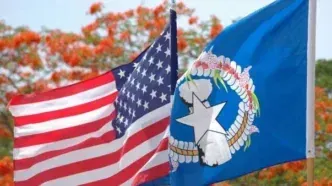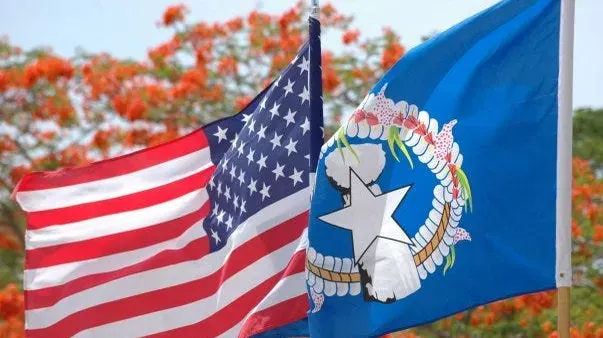The number of undocumented Chinese immigrants entering the U.S. has surged in recent years. However, they don’t always have to travel far to cross American borders.
Chinese Man Sentenced for Smuggling Attempt to Guam
A Chinese national has been sentenced to federal prison for attempting to smuggle undocumented immigrants from China to the remote U.S. territory of Guam, federal officials announced Tuesday.
Zhongli Pang sought to exploit a loophole that allows Chinese visitors to enter the Northern Mariana Islands without a visa, unlike Guam. This visa waiver is designed to encourage tourism in the Marianas, where a U.S. visa isn’t required. However, some Chinese migrants take advantage of this policy, attempting to travel over 100 miles southwest by sea to Guam, where better wages are available but a U.S. visa is mandatory.
Pang was sentenced to three months in prison for transporting a dozen Chinese nationals from Saipan, the largest island in the Northern Marianas, to Guam. His overloaded boat, named Helen, ran out of fuel before reaching the island, prompting a U.S. Coast Guard rescue, according to U.S. prosecutors.
U.S. Territories as Immigration Gateways
This case from the Commonwealth of the Northern Mariana Islands (CNMI) highlights ongoing efforts to curb illegal immigration into U.S. territories. While thousands of miles from the continental U.S., these territories serve as key crossing points for people fleeing China.
“We will continue to target illegal aliens unlawfully traveling between the CNMI and Guam,” said Shawn N. Anderson, the U.S. Attorney’s Office for Guam and the Northern Mariana Islands. “The risk to personal safety is substantial. Those interdicted also face imprisonment and immigration penalties. We urge PRC nationals to fully comply with the CNMI’s parole program and return to China.”
The 36-year-old, known to his passengers as “Captain Pang,” pleaded guilty to conspiracy to transport illegal aliens and conspiracy to defraud the United States. In addition to his prison sentence, he was ordered to complete 50 hours of community service.
The Smuggling Route
Pang attempted to make the crossing from Saipan last June, court documents reveal. His route is commonly used by human traffickers operating in remote U.S. territories, according to Homeland Security Investigations.
Smugglers typically use small recreational boats for the 133-mile journey from Saipan to Guam. A federal analysis of regional trafficking indicates that undocumented immigrants often pool money to purchase these boats, usually in the Northern Mariana Islands, where a spot on board costs between $3,000 and $5,000.
Pang and his associates bought the Helen for $33,000, the U.S. Attorney’s Office reported.
Guam remains a prime destination because of its higher wages compared to other locations in the Pacific. Many undocumented immigrants first travel to the Northern Mariana Islands, where Chinese visitors can enter without a visa, before attempting the risky journey to Guam.
Smugglers often land at secluded beaches, Homeland Security officials said.
A Growing Trend in Illegal Immigration
While much of the immigration debate centers on the U.S.-Mexico border, people from across the world seek entry into the United States. For Chinese migrants, America’s remote territories offer a unique opportunity.
Last month, Chinese national HongJiang Yang was sentenced for attempting to smuggle several Chinese immigrants to Guam from the Northern Mariana Islands. Authorities intercepted them off the coast of Rota—the closest island to Guam—after their overloaded boat ran out of fuel, similar to Pang’s case.
In February, another Chinese national, Kangle Jiang, was sentenced for trying to smuggle himself and seven others to Guam from Saipan. He pleaded guilty to the same charges as Pang.
“The arrest of Mr. Jiang exemplifies HSI’s commitment to enforcing federal immigration laws to prevent human smuggling,” said Homeland Security Investigations Special Agent in Charge Lucy Cabral-DeArmas. “By going after violators like Mr. Jiang, we protect our communities from the dangers posed by smuggling.”
Sharp Increase in Undocumented Chinese Immigration
The number of undocumented Chinese immigrants entering the U.S. has reached historic levels in recent years.
While Pacific routes remain popular, tens of thousands have been arriving at the U.S.-Mexico border, where most undocumented immigrants enter the country.
Between fiscal years 2022 and 2023, the number of Chinese immigrants arriving at the southern border skyrocketed by nearly 1,000%, according to a Migration Policy Institute analysis of U.S. Customs and Border Protection data.
In 2023, approximately 24,300 Chinese nationals crossed the U.S.-Mexico border, compared to just 2,200 in 2022. The number continued to rise in fiscal year 2024, reaching about 38,200. The U.S.-Canada border also saw an increase, nearly doubling from 6,700 arrivals in 2022 to 12,400 in 2024, according to the nonpartisan immigration research institute.
Researchers attribute this surge to China’s struggling economy and social challenges arising from the country’s stringent COVID-19 restrictions.
Many of these immigrants rely on smugglers—referred to as “snakeheads”—and online tutorials found on platforms like TikTok, researchers said.
Understanding the Northern Mariana Islands
The Commonwealth of the Northern Mariana Islands is one of five U.S. territories worldwide. Located at the eastern edge of the Philippine Sea, these 14 islands, along with Guam, form the Mariana Archipelago.
According to U.S. Census data, approximately 47,000 people live in the commonwealth, primarily on Saipan, Rota, and Tinian.
The islands cover an area roughly two and a half times the size of Washington, D.C., and sit three-quarters of the way between Hawaii and the Philippines, according to the CIA’s World Factbook.
The U.S. took control of the islands after World War II, and they officially became a U.S. territory in 1986, granting residents American citizenship.
Although islanders cannot vote in presidential elections, they have been able to send a delegate to Congress since 2009.
This Article Includes













